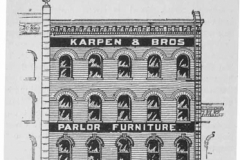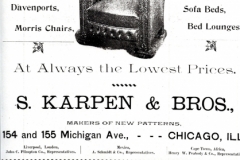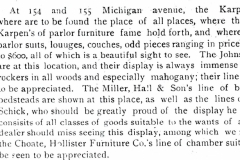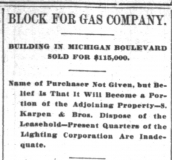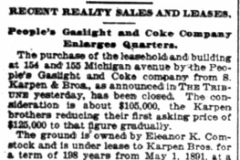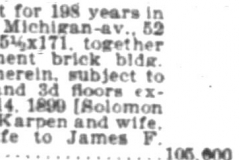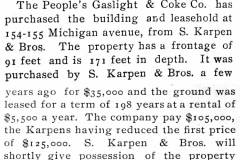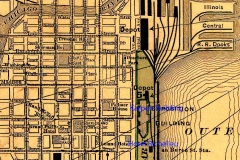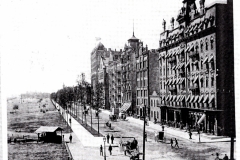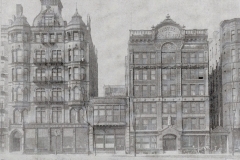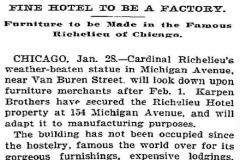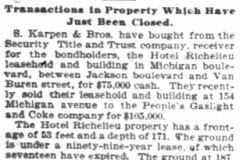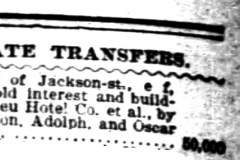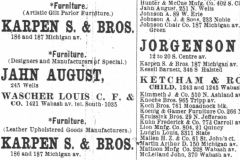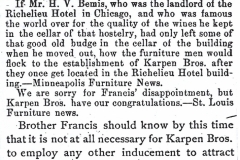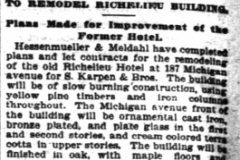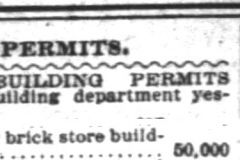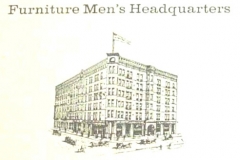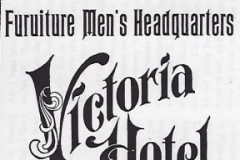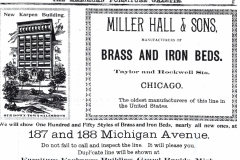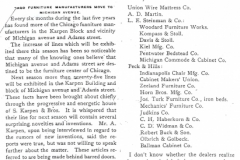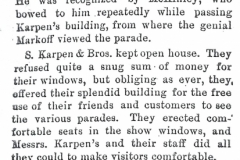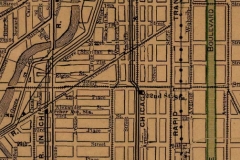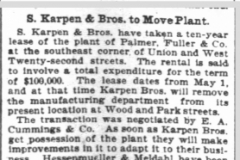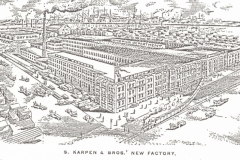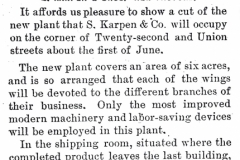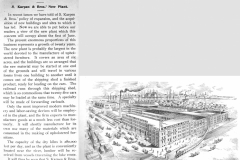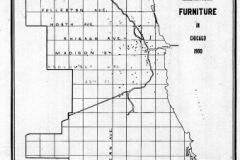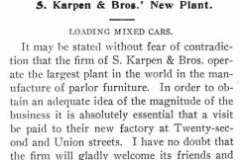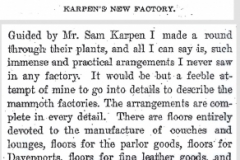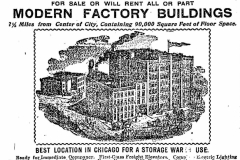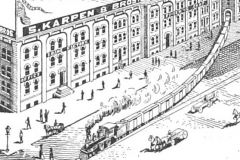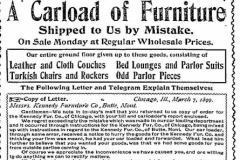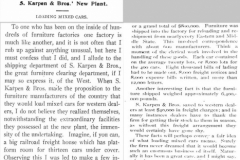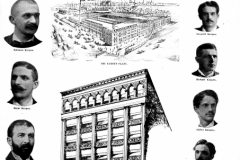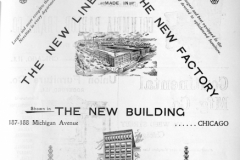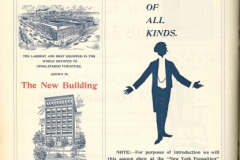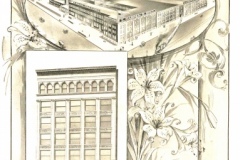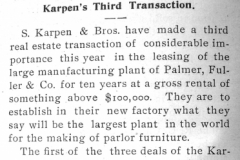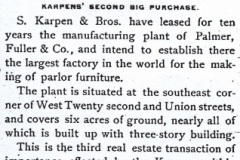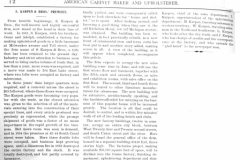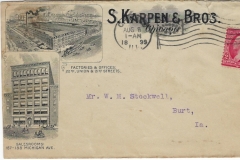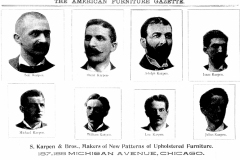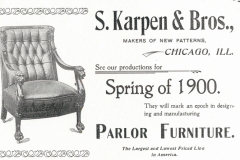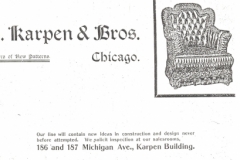The Great Expansion: 1899-1902
From humble beginnings, S. Karpen & Bros., the well-known and highly successful firm, now stands at the head in its line of work. —American Cabinet Maker and Upholsterer, June 24, 1899, 12.
Sale of the Karpen Building at 154-155 Michigan Avenue
In an entrepreneurial business—with success building rapidly on success—it would be easy to attribute it to luck. While the brothers’ work ethic and creative abilities in the furniture side of the business cannot be denied, luck did seem play of role in their real estate dealings. Luck in those transactions was a combination of being ready to take advantage of an opportunity and pure serendipity.
Karpen Bros’ showrooms occupied most of the floors in the Karpen Building at 154-155 Michigan Avenue, north of Adams Street.
In the late 1890s, the People’s Gaslight and Coke Company bought the building adjoining the Karpen building for its headquarters. It quickly outgrew those premises and was eager to acquire the Karpen Building. What made that prospect even more enticing was that each floor of the two building was exactly at the same horizontal level, making the remodeling task quite manageable.
Since 1892 when Karpen Bros. bought this building, the land had increased in valued due to the improvement of Lake Front Park on the shore of Lake Michigan. The Chicago Tax Commission valued the property at $142,500 and the building at $58,189, a total of $200,680.[1] At first, Karpen Bros.’ asking price was $125,000, but gradually it was lowered to the final price of $105,000 and sold at the end of 1898. Considering Solomon, Oscar, and Adolph and their wives had purchased the building for $35,000 in 1892, it was “not a bad investment.”[2]
Purchase of New Karpen Building at 187-188 Michigan Avenue
Karpen Bros. needed a new building for its own and other manufacturers’ showrooms. At the end of January 1899, Solomon, Adolph and Oscar purchased the famed Hotel Richelieu, 187-188 Michigan Avenue between Jackson Boulevard and Van Buren Street.[3] (After 1909, its address would be 318-320 Michigan Avenue.) Built in 1885 the Hotel Richelieu was world-renown; its interior was the height of opulence. Among the persons who had enjoyed the luxuries of the hotel were Grand Duke Alexander of Russia, Prince Jerome Napoleon of France, and John D. Rockefeller.”[4] The hotel had closed in 1895, and the building had not been occupied for several years.
The three brothers paid $75,000 in cash. The 90-year ground lease had about 82 years remaining. The total ground lease rental was $1,344 a year, which was remarkably low. [5] To finance the leasehold and building, Karpen Bros. issued $300,000 in bonds which sold for a discount for $260,000 when they were originally placed. Karpen Bros. considered that they have “secured an exceptional bargain,”[6] and even “without doubt one of the biggest bargains in real estate Chicago has ever offered.” [7]
The ground and building had a frontage of 53 ft. and a depth of 171 ft. The brick building’s front part was six stories high, and the back was part seven stories.[8] The new Karpen Building was completely reconstructed and adapted to the uses of a furniture wareroom. An additional story was added to the front part of the building to make it conform to the rear. The front of the first, second, and third stories facing Michigan Avenue were removed and replaced with a more attractive one, with broad plate glass windows and ornamental bronze-plated cast iron trimmings “of unique design.”[9] The upper stories were transformed into cream colored terracotta.[10] The interior was entirely taken out and replaced with fireproof materials[11] (yellow pine timbers and iron columns). [12] The building was finished in oak with hardwood maple floors and equipped with a freight elevator, one passenger electric elevator and an electric light and power plant.[13] The total cost of the improvements was estimated at $35,000,[14] but in the end $60,000 was invested in the project. [15]
Again, the location served the traveling buyers and dealers well, being “five minutes’ walk of all the leading hotels and clubs.”[16]
The remodeling took several months. To announce the building’s official opening in June 1899, Karpen Bros. mailed to the trade a postal invitation to come to Chicago and visit the new Karpen Building to see “the largest and lowest price line of upholstered furniture in the world.”[17] Karpen Bros.’ showrooms occupied the basement, first, fifth, sixth, and seventh floors, with the sales offices on the first floor. [18] The second, third and fourth floors were rented to other furniture manufacturers. The building was called “one of the finest in the city.”[19]
The new building and Karpen Bros.’ hospitality were shown off with great success when President William McKinley visited Chicago on Chicago Day, October 9, 1899:
By 1900 nine buildings in the vicinity of Michigan Avenue and Congress Street housed permanent salesrooms for both Chicago and out-of-town companies.[20]
The New Karpen Factory
As big as those two real estate transactions were, S. Karpen & Bros. made an even more ambitious investment in February 1899. It took a 10-year lease on the former sash, door and blind plant of Palmer, Fuller & Co. at the southeast corner of Union and West 22nd streets (after 1933, 638 W. Cermak Rd) on the Near South Side. Palmer, Fuller & Co. had not used the factory for at least two years.[21] The 10-year lease agreement involved a total expenditure of more than $100,000. [22] The new factory buildings, 12 in number, occupied 6 acres, an entire city block, between West 21st and 22nd streets, and South Union Street and the Chicago River. [23] The tract’s frontage covered 511 ft. on Union Street and 365 ft. on 21st and 22nd Streets.[24] The factories covered 200,000 sq. ft. [25]
As soon as Karpen Bros. got possession of the plant, it made improvements to adapt it to its business. The same architectural firm, which modified its new sales building, designed a new 3-story building, 60 ft. by 100 ft., on the 22nd Street side.[26] It also made changes in the buildings adding floors, elevators, and structural connections between the buildings. The total remodeling project was completed in 4 months at an expenditure of $15,000.[27]
Karpen Bros.’ new acquisition was immediately acknowledged as the largest upholstered furniture plant in the world.[28] However, what the firm did with this plant in 1899 was even more impressive. To put these achievements in historical perspective, we only need to note that the first automobile was mass produced in 1901 and Henry Ford’s mass production factory made history in 1903. Karpen Bros.’ innovations in the mass production of upholstered furniture pre-dated those much-heralded events.
As reported in the trade press, in 1899, only the most improved modern machinery and labor-saving devices would be employed in the plant, and the firm expects to manufacture goods at a much less cost than formerly. [29] The additional room in the new factory (200,000 sq. ft. compared to 90,000) [30] permitted the proper division of labor, reducing the cost of manufacturing to a minimum. [31] “A better equipped plant, one better systematized or better arranged to expedite the manufacture and rapid handling of upholstered furniture, does not exist.”[32]
Karpen Bros. designed a mass production system beginning with the raw products. The plant was conveniently located near the river so that he lumber for the frames was received from vessels traversing the lake route.[33] Then the wood was dried in its drying kilns with a capacity 280,000 ft. per day, the largest in Chicago. [34] The plant buildings were so arranged that the raw materials started at the one end of the grounds and were progressively moved in various forms from one building to another until they came out of the shipping shed a finished product, ready for loading on railroad cars. A series of three closely connected buildings were divided into the frame factory, finishing department, upholstering department and shipping department. [35] The general offices were housed in a separate 3-story 40 ft. by 40 ft. building.[36] Furniture industry reporters praised the new factory:
Karpen Bros. put its former factory up for “cheap” sale or rent immediately.
Shipping Westward
Another consequence of Karpen Bros.’ purchase of its huge plant was the creation of a new business venture, one which certainly had been contemplated prior to its acquisition. A spur of the important Chicago, Burlington & Quincy Railroad (C. B. & Q. R. R.) Line ran the entire length of the shipping shed;[37] the shipping shed was so commodious that 25 railroad cars could be loaded at the same time.[38] An innovative proposal was presented to other furniture manufacturers: Karpen Bros. would load mixed cars (cargo produced by several manufacturers) for shipment to western retailers. A trade paper reporter toured the Karpen shipping facility and wrote of the incredible undertaking calling it “the great furniture clearing department of the West.” Karpen Bros.’ new venture filled an immediate need, but the logistics were challenging.
A reporter described with incredulity the undertaking in December 1899:
Publicizing its Achievements
Never shy to publicize its achievements, Karpen Bros. brought out new advertisements touting its new sales building and factory. The furniture journals took notice of its purchases:
In the June 24, 1899 issue, American Cabinet Maker and Upholsterer featured the Karpen brothers and the new factory and building in a long article in its special section on “Chicago’s Wholesale Furniture Manufacturers:”
“S. Karpen & Bros.’ Premises” (American Cabinet Maker and Upholsterer, June 24, 1899, 12.)
As was the custom of the day, Karpen Bros. included printed images of its new signature buildings on company letterheads and envelopes.
Adolph Karpen was very optimistic at the dawn of the new century, as he wrote in a furniture industry journal:
The year which is about to close has witnessed the greatest activity in the manufacturers of furniture and kindred produces which this country has experienced since 1892. That year marked the highest development of this branch of industry. Since then, and up to the year 1899, there has been a general decline. This was caused mainly by the influence of the panics, when the public curtailed first of all its expenditures in this direction. When the general conditions changed, and prosperity swept over the country, it found almost every home in the land sorely in need of furniture, and, moreover, the necessary means for purchasing were not lacking, but the factories then in existence were not able to supply the suddenly increasing and tremendous demand for all kinds of household goods, and the greatest difficulty which retail dealers have experienced in the last six months has been to maintain their stocks….
Chicago continues to lead as the largest furniture market in the United States. The total output for 1899 exceeded in volume the sum of $23,000,000. Chicago furniture factories employed about 25,000 men. The industry was never in a more robust condition, and I look for 1900 to even excel 1899.[39]
Karpen Bros. entered the 20th century ready to make its mark on the furniture industry.
In January 1902, S. Karpen & Bros. was incorporated in Illinois. The incorporators were Solomon Karpen, Oscar Karpen, and Adolph Karpen. The capital stock was $750,000. Then each brother conveyed his company real estate properties by quitclaims to the new corporation.In June 1872, the Karpen family arrived in America with only a few dollars and a dream. Just thirty years later, the family owned a major corporation.
- Chicago Daily Tribune, Jan. 7, 1899. ↑
- American Cabinet Maker and Upholsterer, June 24, 1899, 12. ↑
- Chicago Daily Tribune, Jan. 29, 1899, 34. ↑
- Furniture Worker, Feb. 10, 1899, 28. ↑
- Chicago Daily Tribune, Jan. 29, 1899. ↑
- Furniture Worker, Feb. 10, 1899, 28. ↑
- Furniture World, Feb. 2, 1899, 23. ↑
- Furniture Worker, Feb. 10, 1899, 28. ↑
- Furniture World, Mar. 2, 1899, 19. ↑
- Chicago Daily Tribune, Jan. 29, 1899. Furniture Worker, Feb. 10, 1899, 28. ↑
- Chicago Daily Tribune, Jan. 29, 1899. Furniture Worker, Feb. 10, 1899, 28. ↑
- Chicago Daily Tribune, Apr. 2, 1899. ↑
- Chicago Daily Tribune, Apr. 2, 1899. ↑
- Chicago Daily Tribune, Jan. 29, 1899. Furniture Worker, Feb. 10, 1899, 28. ↑
- Chicago Daily Tribune, Nov. 26, 1902; Nov. 30, 1902. ↑
- American Cabinet Maker and Upholsterer, June 24, 1899, 12. ↑
- Furniture World, July 6, 1899, 39. ↑
- Chicago Daily Tribune, Apr. 12, 899. ↑
- American Furniture Gazette, Dec. 1899, 11. ↑
- Chicago Furniture Manufacturers Association. “Chicago Furniture Manufacturers Association: 50 Forward Years 1888-1938.” Chicago: Furniture Manufacturers Association, 1938, 11. ↑
- Chicago Daily Tribune, Feb. 26, 1899. ↑
- Chicago Daily Tribune, Feb. 25, 1899. ↑
- American Cabinet Maker and Upholsterer, June 24, 1899, 12. ↑
- Chicago Daily Tribune, Feb. 25, 1899. Furniture World, Mar. 9, 1899, 22. ↑
- American Cabinet Maker and Upholsterer, June 24, 1899, 12. ↑
- Chicago Daily Tribune, Feb. 26, 1899. ↑
- Chicago Daily Tribune, Feb. 25, 1899. Furniture World, Mar. 9, 1899, 22. ↑
- Furniture Worker, Apr. 10, 1899, 24. Furniture World, Mar. 9, 1899, 22. Furniture World, Apr. 27, 1899, 21. American Cabinet Maker and Upholsterer, June 24, 1899, 12. “S. Karpen & Bros.’ New Plant. Loading Mixed Cars,” Furniture World, Dec. 14, 1889, 18. Furniture Trade Review, Dec. 10, 1899, 60E. ↑
- Furniture World, Apr. 27, 1899, 21. ↑
- Chicago Daily Tribune, Mar. 26, 1899. ↑
- American Cabinet Maker and Upholsterer, June 24, 1899, 12. ↑
- “S. Karpen & Bros.’ New Plant. Loading Mixed Cars,” Furniture World, Dec. 14, 1889, 17. ↑
- Furniture World, Apr. 27, 1899, 21. ↑
- Furniture World, Apr. 27, 1899, 21. American Cabinet Maker and Upholsterer, June 24, 1899, 12. ↑
- American Cabinet Maker and Upholsterer, June 24, 1899, 12. ↑
- American Cabinet Maker and Upholsterer, June 24, 1899, 12. ↑
- American Cabinet Maker and Upholsterer, June 24, 1899, 12. ↑
- Furniture World, Apr. 27, 1899, 21. ↑
- Furniture World, Jan. 4, 1900, 43. 1902: Chicago Daily Tribune, January 22, 1902. Inter Ocean (Chicago), January 22, 1902.Chicago Daily Tribune, February 18, 1902. February 23, 1902. “Deals of a Day in Real Estate.” Inter Ocean (Chicago), February 18, 1902.↑
